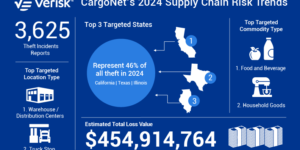Moody’s RMS estimates total economic losses from the recent California flooding at between $5 billion and $7 billion, and insured losses are anticipated to be between $500,000 and $1.5 billion, including losses to the National Flood Insurance Program and the private flood market.
The estimate reflects inland flood impacts for the U.S. and includes damage to infrastructure.
The overall economic loss estimate is based on an event reconstruction using the Moody’s RMS U.S. Inland Flood HD Model and reflects property damage, contents, and business interruption, across residential, commercial, industrial, automobile and infrastructure assets.
A series of extratropical cyclones starting Dec. 26, 2022 impacted the West Coast of the U.S, which resulted in heavy rainfall, overflowing rivers, flash floods, levee breaches, mudslides, fallen trees, debris flow, and heavy snow at high altitudes, together with some wind damage.
The rainfall associated with these cyclones was exacerbated by a band of high atmospheric water vapor, also known as an “atmospheric river.”
The rainfall intensity in California was so extreme that several locations in central California set 3-week record rainfall and certain locations received their annual average rainfall totals in less than one month.
Infrastructure damage, accounted for within the economic loss estimates, was extensive. State highways and local roads bore the brunt of the damage due to a combination of flooding and mudslides. Trees previously stressed by dry conditions were uprooted due to high water velocities, saturated soils and heavy winds, which also caused damage to power networks, as well as to cars and properties.
A relatively small proportion of the economic damage is expected to be covered by insurance. The number of households in California with flood insurance stands at less than 2 percent. As of August 2022, there were only 193,281 residential NFIP policies in place, according to Moody’s RMS.





















 Many Reasons Behind Certain Homes Left Standing After Wildfires
Many Reasons Behind Certain Homes Left Standing After Wildfires  Leading Insurance Innovation in the AI Age (Part 1: Culture)
Leading Insurance Innovation in the AI Age (Part 1: Culture)  As Life Shifts Gears, Insurance CEO Chases Racing Dream
As Life Shifts Gears, Insurance CEO Chases Racing Dream  Rapid Response Effort Initiated to Respond to Fraud After Wildfires
Rapid Response Effort Initiated to Respond to Fraud After Wildfires 
